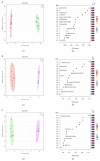Blood Metabolite Profiling of Antarctic Expedition Members: An 1H NMR Spectroscopy-Based Study
- PMID: 37176166
- PMCID: PMC10179003
- DOI: 10.3390/ijms24098459
Blood Metabolite Profiling of Antarctic Expedition Members: An 1H NMR Spectroscopy-Based Study
Abstract
Serum samples from eight participants during the XV winter-over at Concordia base (Antarctic expedition) collected at defined time points, including predeparture, constituted the key substrates for a specific metabolomics study. To ascertain acute changes and chronic adaptation to hypoxia, the metabolic profiles of the serum samples were analyzed using NMR spectroscopy, with principal components analysis (PCA) followed by partial least squares and orthogonal partial least squares discriminant analyses (PLS-DA and OPLS-DA) used as supervised classification methods. Multivariate data analyses clearly highlighted an adaptation period characterized by an increase in the levels of circulating glutamine and lipids, mobilized to supply the body energy needs. At the same time, a reduction in the circulating levels of glutamate and N-acetyl glycoproteins, stress condition indicators, and proinflammatory markers were also found in the NMR data investigation. Subsequent pathway analysis showed possible perturbations in metabolic processes, potentially related to the physiological adaptation, predominantly found by comparing the baseline (at sea level, before mission onset), the base arrival, and the mission ending collected values.
Keywords: Antarctica; Concordia base; NMR; adaptation; hypoxia; metabolomics; winter-over.
Conflict of interest statement
The authors declare no conflict of interest.
Figures




Similar articles
-
Study on plasmatic metabolomics of Uygur patients with essential hypertension based on nuclear magnetic resonance technique.Eur Rev Med Pharmacol Sci. 2014;18(23):3673-80. Eur Rev Med Pharmacol Sci. 2014. PMID: 25535139
-
Urine metabolite profiling of Indian Antarctic Expedition members: NMR spectroscopy-based metabolomic investigation.Heliyon. 2021 May 25;7(5):e07114. doi: 10.1016/j.heliyon.2021.e07114. eCollection 2021 May. Heliyon. 2021. PMID: 34113732 Free PMC article.
-
Evidence for altered metabolic pathways during environmental stress: (1)H-NMR spectroscopy based metabolomics and clinical studies on subjects of sea-voyage and Antarctic-stay.Physiol Behav. 2014 Aug;135:81-90. doi: 10.1016/j.physbeh.2014.05.045. Epub 2014 Jun 5. Physiol Behav. 2014. PMID: 24910139
-
Multivariate analysis of NMR-based metabolomic data.NMR Biomed. 2022 Feb;35(2):e4638. doi: 10.1002/nbm.4638. Epub 2021 Nov 5. NMR Biomed. 2022. PMID: 34738674 Review.
-
Metabolomics technology and their application to the study of the viral infection.J Matern Fetal Neonatal Med. 2014 Oct;27 Suppl 2:53-7. doi: 10.3109/14767058.2014.955963. J Matern Fetal Neonatal Med. 2014. PMID: 25284178 Review.
Cited by
-
Restoring autophagic function: a case for type 2 diabetes mellitus drug repurposing in Parkinson's disease.Front Neurosci. 2023 Nov 3;17:1244022. doi: 10.3389/fnins.2023.1244022. eCollection 2023. Front Neurosci. 2023. PMID: 38027497 Free PMC article. Review.
References
-
- Eswaran V. A Diffusion Wave out of Africa. Curr. Anthropol. 2002;43:749–774. doi: 10.1086/342639. - DOI
-
- Bigham A.W. Natural Selection and Adaptation to Extreme Environments: High Latitudes and Altitudes. In: O’Rourke D.H., editor. A Companion to Anthropological Genetics. Wikley; Hoboken, NJ, USA: 2019. p. 219. Chapter 15.
-
- Kaleel Rahman N.R., Chung A. Pathophysiology of respiratory disease and its significance to anaesthesia. Anaesth. Intensive Care Med. 2022;23:674–680. doi: 10.1016/j.mpaic.2022.08.006. - DOI
MeSH terms
Grants and funding
LinkOut - more resources
Full Text Sources

